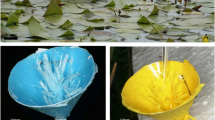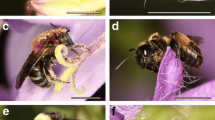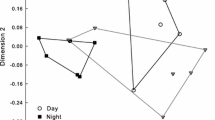Abstract
Olfactory cues constitute one of the most important plant-pollinator communication channels. Specific chemical components can be associated with specific pollinator functional groups due to pollinator-mediated selection on flower volatile (FV) emission. Here, we used multivariate analyses of FV data to detect an association between FVs and the worldwide distributed pollinator group of the carpenter bees (Xylocopa spp.). We compiled FVs of 29 plant species: 9 pollinated by carpenter bees, 20 pollinated by other bee pollinator functional groups. We tested whether FV emission differed between these groups. To rule out any phylogenetic bias in our dataset, we tested FV emission for phylogenetic signal. Finally, using field assays, we tested the attractive function of two FVs found to be associated with carpenter bees. We found no significant multivariate difference between the two plant groups FVs. However, seven FVs (five apocarotenoid terpenoids, one long-chain alkane and one benzenoid) were significantly associated with carpenter bee pollination, thus being “predictor” compounds of pollination by this pollinator functional group. From those, β-ionone and (E)-methyl cinnamate presented the highest indicator values and had their behavioural function assessed in field assays. Phylogenetic signal for FVs emission was weak, suggesting that their emission could result from pollinator-mediated selection. In field assays, the apocarotenoid β-ionone attracted carpenter bees, but also bees from other functional groups. The benzenoid (E)-methyl cinnamate did not attract significant numbers of pollinators. Thus, β-ionone functions as a non-specific bee attractant, while apocarotenoid FVs emerge as consistent indicators of pollination by large food-foraging bees among bee-pollinated flowers.



Similar content being viewed by others
References
Ackerman JD, Meléndez-Ackerman EJ, Salguero-Faria J (1997) Variation in pollinator abundance and selection on fragrance phenotypes in an epiphytic orchid. Am J Bot 84:1383–1390. https://doi.org/10.2307/2446136
Agostini K, Sazima M (2003) Plantas ornamentais e seus recursos para abelhas no campus da Universidade Estadual de Campinas, Estado de São Paulo, Brasil. Bragantia 62:335–343. https://doi.org/10.1590/S0006-87052003000300001
Azuma H, Toyota M, Asakawa Y et al (1997) Chemical divergence in floral scents of Magnolia and allied genera (Magnoliaceae). Plant Species Biol 12:69–83. https://doi.org/10.1111/j.1442-1984.1997.tb00159.x
Barkman TJ (2001) Character coding of secondary chemical variation for use in phylogenetic analyses. Biochem Syst Ecol 29:1–20. https://doi.org/10.1016/S0305-1978(00)00031-4
Barkman TJ, Beaman JH, Gage DA (1997) Floral fragrance variation in Cypripedium: implications for evolutionary and ecological studies. Phytochemistry 44:875–882. https://doi.org/10.1016/S0031-9422(96)00614-0
Bell CD, Soltis DE, Soltis PS (2010) The age and diversification of the angiosperms re-revisited. Am J Bot 97:1296–1303. https://doi.org/10.3732/ajb.0900346
Blomberg SP, Garland T Jr, Ives AR (2003) Testing for phylogenetic signal in comparative data: behavioral traits are more labile. Evolution 57:717–745. https://doi.org/10.1111/j.0014-3820.2003.tb00285.x
Braga PIS (1977) Aspectos biológicos das Orchidaceae de uma campina da Amazônia Central. Acta Amaz 7:5–89. https://doi.org/10.1590/1809-43921977072s005
Bronstein JL, Barker JL, Lichtenberg EM, Richardson LL, Irwin RE (2017) The behavioral ecology of nectar robbing: why be tactic constant? Curr Opin Insect Sci 21:14–18. https://doi.org/10.1016/j.cois.2017.05.013
Córdoba SA, Cocucci AA (2011) Flower power: its association with bee power and floral functional morphology in papilionate legumes. Ann Bot 108:919–931. https://doi.org/10.1093/aob/mcr196
De Caceres MD, Legendre P (2009) Associations between species and groups of sites: indices and statistical inference. Ecology 90:3566–3574
De Luca PA, Vallejo-Marín M (2013) What’s the “buzz” about? The ecology and evolutionary significance of buzz-pollination. Curr Opin Plant Biol 16:429–435. https://doi.org/10.1016/j.pbi.2013.05.002
Dobson HEM (1994) Floral volatiles in insect biology. In: Insect-plant interactions. CRC Press, Boca Raton, Florida, pp 47–81
Dobson HEM (2006) Relationship between floral fragrance composition and type of pollinator. In: Dudareva NA, Pichersky E (eds) Biology of floral scent, 1st edn. CRC Press, Boca Raton, FL, pp 147–198
Dobson HEM, Arroyo J, Bergström G, Groth I (1997) Interspecific variation in floral fragrances within the genus Narcissus (Amaryllidaceae). Biochem Syst Ecol 25:685–706. https://doi.org/10.1016/S0305-1978(97)00059-8
Dudareva N, Negre F, Nagegowda DA, Orlova I (2006) Plant volatiles: recent advances and future perspectives. CRC Crit Rev Plant Sci 25:417–440. https://doi.org/10.1080/07352680600899973
Dufrêne M, Legendre P (1997) Species assemblages and indicator species: the need for a flexible asymmetrical approach. Ecol Monogr 67:345–366
Ellis AG, Johnson SD (2009) The evolution of floral variation without pollinator shifts in Gorteria diffusa (Asteraceae). Am J Bot 96:793–801. https://doi.org/10.3732/ajb.0800222
El-Sayed AM (2020) The Pherobase: database of pheromones and semiochemicals. In: The Pherobase. http://www.pherobase.com. Accessed 6 Sep 2020
Eltz T, Sager A, Lunau K (2005) Juggling with volatiles: exposure of perfumes by displaying male orchid bees. J Comp Physiol A Neuroethol sensory, neural, Behav Physiol 191:575–581. https://doi.org/10.1007/s00359-005-0603-2
Eltz T, Ayasse M, Lunau K (2006) Species-specific antennal responses to tibial fragrances by male orchid bees. J Chem Ecol 32:71–79. https://doi.org/10.1007/s10886-006-9352-0
Fenster CB, Armbruster WS, Wilson P, Dudash MR, Thomson JD (2004) Pollination syndromes and floral specialization. Annu Rev Ecol Syst 35:375–403. https://doi.org/10.2307/annurev.ecolsys.34.011802.30000015
Filella I, Primante C, Llusià J, Martín González AM, Seco R, Farré-Armengol G, Rodrigo A, Bosch J, Peñuelas J (2013) Floral advertisement scent in a changing plant-pollinators market. Sci Rep 3:3434. https://doi.org/10.1038/srep03434
Gershenzon J, Kreis W (1999) Biochemistry of terpenoids: monoterpenes, sesquiterpenes, diterpenes, sterols, cardiac glycosides and steroid saponins. In: Wink M (ed) Biochemistry of plant secondary metabolism, annual plant reviews, Volume 2. Sheffield Academic Press, Sheffield, pp 222–299
Gervasi DDL, Schiestl FP (2017) Real-time divergent evolution in plants driven by pollinators. Nat Commun 8:14691. https://doi.org/10.1038/ncomms14691
Hoehn P, Tscharntke T, Tylianakis JM, Steffan-Dewenter I (2008) Functional group diversity of bee pollinators increases crop yield. Proc R Soc B Biol Sci 275:2283–2291. https://doi.org/10.1098/rspb.2008.0405
Janzen DH (1971) Euglossine bees as long-distance pollinators of tropical plants. Science 171(80):203–205. https://doi.org/10.1126/science.171.3967.203
Jarek S (2012) Mvnormtest: normality test for multivariate variables. R Foundation for Statistical Computing, Vienna
Junker RR, Blüthgen N (2008) Floral scents repel potentially nectar-thieving ants. Evol Ecol Res 10:295–308
Junker RR, Blüthgen N (2010) Floral scents repel facultative flower visitors, but attract obligate ones. Ann Bot 105:777–782. https://doi.org/10.1093/aob/mcq045
Junker RR, Parachnowitsch AL (2015) Working towards a holistic view on flower traits— how floral scents mediate plant–animal interactions in concert with other floral characters. J Indian Inst Sci 95:43–68
Kantsa A, Raguso RA, Dyer AG, Sgardelis SP, Olesen JM, Petanidou T (2017) Community-wide integration of floral colour and scent in a Mediterranean scrubland. Nat Ecol Evol 1:1502–1510. https://doi.org/10.1038/s41559-017-0298-0
Keasar T (2010) Large carpenter bees as agricultural pollinators. Psyche A J Entomol 2010:1–7. https://doi.org/10.1155/2010/927463
Kessler D, Gase K, Baldwin IT (2008) Field experiments with transformed plants reveal the sense of floral scents. Science 321(80):1200–1202. https://doi.org/10.1126/science.1160072
Kessler D, Diezel C, Clark DG, Colquhoun TA, Baldwin IT (2013) Petunia flowers solve the defence/apparency dilemma of pollinator attraction by deploying complex floral blends. Ecol Lett 16:299–306. https://doi.org/10.1111/ele.12038
Knudsen J, Eriksson R, Gershenzon J, Ståhl B (2006) Diversity and distribution of floral scent. Bot Rev 72:1–120. https://doi.org/10.1663/0006-8101(2006)72
Laloi D, Pham-Delègue M-H (2004) Bumble bees show asymmetrical discrimination between two odors in a classical conditioning procedure. J Insect Behav 17:385–396. https://doi.org/10.1023/B:JOIR.0000031538.15346.e1
Laloi D, Bailez O, Blight MM, Roger B, Pham-Delègue MH, Wadhams LJ (2000) Recognition of complex odors by restrained and free-flying honeybees, Apis mellifera. J Chem Ecol 26:2307–2319. https://doi.org/10.1023/A:1005522826673
Legendre P, Gallagher ED (2001) Ecologically meaningful transformations for ordination of species data. Oecologia 129:271–280
Leys R, Cooper SJB, Schwarz MP (2002) Molecular phylogeny and historical biogeography of the large carpenter bees, genus Xylocopa (Hymenoptera: Apidae). Biol J Linn Soc 77:249–266. https://doi.org/10.1046/j.1095-8312.2002.00108.x
Linstrom PJ, Mallard WG (2011) NIST chemistry Webbook, NIST standard reference database number 69. In: NIST Chem. Webb. http://webbook.nist.gov. Accessed 6 Sep 2020
Lunau K (1992) Evolutionary aspects of perfume collection in male euglossine bees (Hymenoptera) and of nest deception in bee-pollinated flowers. Chemoecology 3:65–73
Lunau K, Papiorek S, Eltz T, Sazima M (2011) Avoidance of achromatic colours by bees provides a private niche for hummingbirds. J Exp Biol 214:1607–1612. https://doi.org/10.1242/jeb.052688
Majetic CJ, Raguso RA, Ashman T-L (2009) The sweet smell of success: floral scent affects pollinator attraction and seed fitness in Hesperis matronalis. Funct Ecol 23:480–487. https://doi.org/10.1111/j.1365-2435.2008.01517.x
Matias LQ, Braga PIS, Freire AG (1996) Biologia reprodutiva de Constantia cipoensis Porto & Brade (Orchidaceae), endêmica da Serra do Cipó, Minas Gerais. Braz J Bot 19:119–125
Michener CD (2007) The bees of the world, 2nd edn. The Johns Hopkins University Press, Baltimore
Mielke PW, Berry KJ (2007) Permutation methods: a distance function approach, 2nd Editio. Springer, Berlin
Morgan HL (1965) The generation of a unique machine description for chemical structures—a technique developed at chemical abstracts service. J Chem Doc 5:107–113. https://doi.org/10.1021/c160017a018
Nemésio A (2009) Orchid bees (Hymenoptera: Apidae) of the Brazilian Atlantic Forest. Zootaxa 1–242. https://doi.org/10.11646/zootaxa.2041.1.1
Nunes CEP, Wolowski M, Pansarin ER, Gerlach G, Aximoff I, Vereecken NJ, Salvador MJ, Sazima M (2017) More than euglossines: the diverse pollinators and floral scents of Zygopetalinae orchids. Sci Nat 104:92. https://doi.org/10.1007/s00114-017-1511-3
Olesen JM, Knudsen JT (1994) Scent profiles of flower colour morphs of Corydalis cava (Fumariaceae) in relation to foraging behaviour of bumblebee queens (Bombus terrestris). Biochem Syst Ecol 22:231–237. https://doi.org/10.1016/0305-1978(94)90096-5
Ollerton J, Winfree R, Tarrant S (2011) How many flowering plants are pollinated by animals? Oikos 120:321–326. https://doi.org/10.1111/j.1600-0706.2010.18644.x
Oksanen J, Blanchet FG, Friendly M, Kindt R, Legendre P, McGlinn D, Minchin PR, O’Hara RB, Simpson GL, Solymos P, Stevens MHH, Szoecs E, Wagner H (2020). vegan: Community Ecology Package. R package version 2.5-7. https://CRAN.R-project.org/package=vegan
Paldi N, Zilber S, Shafir S (2003) Associative olfactory learning of honeybees to differential rewards in multiple contexts - effect of odor component and mixture similarity. J Chem Ecol 29:2515–2538. https://doi.org/10.1023/A:1026362018796
Paradis E, Schliep K (2019) Ape 5.0: an environment for modern phylogenetics and evolutionary analyses in R. Bioinformatics 35:526–528. https://doi.org/10.1093/bioinformatics/bty633
Pérez-Barrales R, Vargas P, Arroyo J (2006) New evidence for the Darwinian hypothesis of heterostyly: breeding systems and pollinators in Narcissus sect. Apodanthi. New Phytol 171:553–567. https://doi.org/10.1111/j.1469-8137.2006.01819.x
R Development Core Team (2020) R Development Core Team, R: a language and environment for statistical computing. R Foundation for Statistical Computing, Vienna
Raguso RA (2004) Flowers as sensory billboards: progress towards an integrated understanding of floral advertisement. Curr Opin Plant Biol 7:434–440. https://doi.org/10.1016/j.pbi.2004.05.010
Revell LJ (2012) Phytools: an R package for phylogenetic comparative biology (and other things). Methods Ecol Evol 3:217–223. https://doi.org/10.1111/j.2041-210X.2011.00169.x
Schäffler I, Steiner KE, Haid M, van Berkel SS, Gerlach G, Johnson SD, Wessjohann L, Dötterl S (2015) Diacetin, a reliable cue and private communication channel in a specialized pollination system. Sci Rep 5:12779. https://doi.org/10.1038/srep12779
Schiestl FP (2017) Innate receiver bias: its role in the ecology and evolution of plant–animal interactions. Annu Rev Ecol Evol Syst 48:585–603. https://doi.org/10.1146/annurev-ecolsys-110316-023039
Schiestl FP, Dötterl S (2012) The evolution of floral scent and olfactory preferences in pollinators: coevolution or pre-existing bias? Evolution 66:2042–2055. https://doi.org/10.1111/j.1558-5646.2012.01593.x
Schiestl FP, Johnson SD (2013) Pollinator-mediated evolution of floral signals. Trends Ecol Evol 28:307–315. https://doi.org/10.1016/j.tree.2013.01.019
Schiestl FP, Roubik DW (2003) Odor compound detection in male euglossine bees. J Chem Ecol 29:253–257. https://doi.org/10.1023/A:1021932131526
Stephanie KB, Albert N, Fernand-Nestor TF (2015) Pollination and yield attributes of (cowpea) Vigna unguiculata L. Walp. (Fabaceae) as influenced by the foraging activity of Xylocopa olivacea Fabricius (Hymenoptera: Apidae) and inoculation with Rhizobium in Ngaoundere, Cameroon. Int J Agron Agric Res 6:62–76
Stone GN (1994) Activity patterns of females of the solitary bee Anthophora plumipes in relation to temperature, nectar supplies and body size. Ecol Entomol 19:177–189. https://doi.org/10.1111/j.1365-2311.1994.tb00408.x
Veloso HP, Rangel-Filho ALR, Lima JCA (1991) Classificação da vegetação brasileira adaptada a um sistema universal. Fundação Instituto Brasileiro de Geografia e Estatística - IBGE, Rio de Janeiro
Vogel S (1966) Parfümsammelnde Bienen als Bestäuber von Orchidaceen und Gloxinia. Österreichische Bot Zeitschrift 113:302–361
Wappler T, Labandeira CC, Engel MS, Zetter R, Grímsson F (2015) Specialized and generalized pollen-collection strategies in an ancient bee lineage. Curr Biol 25(23):3092–3098
Williams NH, Whitten WM (1983) Orchid floral fragrances and male euglossine bees: methods and advances in the last sesquidecade. Biol Bull 164:355–395. https://doi.org/10.2307/1541248
Williams NH, Whitten WM (1999) Molecular phylogeny and floral fragrances of male euglossine bee-pollinated orchids: a study of Stanhopea (Orchidaceae). Plant Species Biol 14:129–136. https://doi.org/10.1046/j.1442-1984.1999.00016.x
Yamamoto M, Da Silva CI, Augusto SC et al (2012) The role of bee diversity in pollination and fruit set of yellow passion fruit (Passiflora edulis forma flavicarpa, Passifloraceae) crop in Central Brazil. Apidologie 43:515–526. https://doi.org/10.1007/s13592-012-0120-6
Zanne AE, Tank DC, Cornwell WK, Eastman JM, Smith SA, FitzJohn RG, McGlinn DJ, O’Meara BC, Moles AT, Reich PB, Royer DL, Soltis DE, Stevens PF, Westoby M, Wright IJ, Aarssen L, Bertin RI, Calaminus A, Govaerts R, Hemmings F, Leishman MR, Oleksyn J, Soltis PS, Swenson NG, Warman L, Beaulieu JM (2014) Three keys to the radiation of angiosperms into freezing environments. Nature 506:89–92. https://doi.org/10.1038/nature12872
Acknowledgments
During the execution of this work, CEPN was supported by the Programa Nacional de Pós-Doutorado - Coordenação de Aperfeiçoamento de Pessoal de Nível Superior – Brasil (CAPES, Institutional Grant to the Department of Plant Biology, UNICAMP) and São Paulo Research Foundation (FAPESP, 2017/22642-5). We thank the Instituto Florestal (Parque Estadual da Serra do Mar, Núcleo Santa Virginia) for supporting research related to the observations in Cattleya loddigesii by Edicson Parra. We thank Vivian Zambon, Aline Binato and Natalia S. Martarello for the pictures in Fig. 3b, c, d, respectively. We also thank Prof. Marlies Sazima for assuring institutional support for this work during the period when GR was an undergrad student under her supervision.
Availability of Data and Material
All data generated or analysed during this study are included in this published article and its supplementary information files.
Code Availability
Not applicable
Funding
During the execution of this work, CEPN was supported by the Programa Nacional de Pós-Doutorado - Coordenação de Aperfeiçoamento de Pessoal de Nível Superior – Brasil (CAPES, Institutional Grant to the Department of Plant Biology, UNICAMP) and Fundação de Amparo à Pesquisa de São Paulo (FAPESP, 2017/22642–5).
Author information
Authors and Affiliations
Contributions
GR and CEPN conceived the ideas, designed methodology and collected the data; GR, CEPN and PJB analysed the data; GR and CEPN led the writing of the manuscript. All authors contributed critically to the drafts and gave final approval for publication.
Corresponding author
Ethics declarations
Conflict of Interest
The authors have no conflicts of interest to declare that are relevant to the content of this article.
Ethics Approval
This article does not contain any studies with human participants or animals performed by any of the authors.
Consent to Participate
Not applicable.
Consent for Publication
Not applicable.
Supplementary Information
Online Resource 1
The 29 bee-pollinated plant species used in the work with their respective main pollinators and with an indication if the plant species is native from the study site (XLSX 15 kb)
Online Resource 2
Percentages of the floral volatile organic compounds (FVs) in the 29 bee-pollinated plant species used in the work. For each plant species, there are the amounts of FVs (in %) categorized into main classes of compounds and then the amounts of each FV individually, with its respective number of registry on CAS (Chemical Abstracts Service of the Chemical American Society) and with the Retention Index (RI) associated to it in the articles used for data compilation or with the RI obtained in laboratory’s identification in the case of Cattleya loddigesii (XLSX 66 kb)
Rights and permissions
About this article
Cite this article
Rabeschini, G., Joaquim Bergamo, P. & Nunes, C.E.P. Meaningful Words in Crowd Noise: Searching for Volatiles Relevant to Carpenter Bees among the Diverse Scent Blends of Bee Flowers. J Chem Ecol 47, 444–454 (2021). https://doi.org/10.1007/s10886-021-01257-y
Received:
Revised:
Accepted:
Published:
Issue Date:
DOI: https://doi.org/10.1007/s10886-021-01257-y




